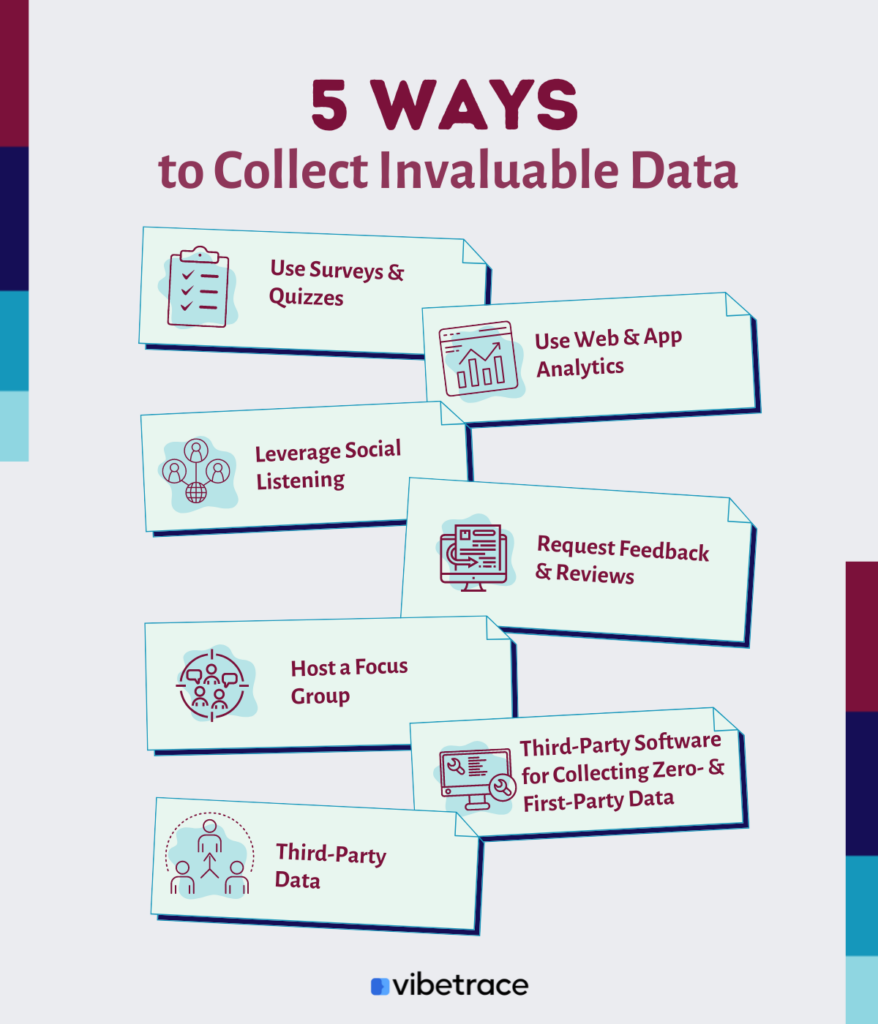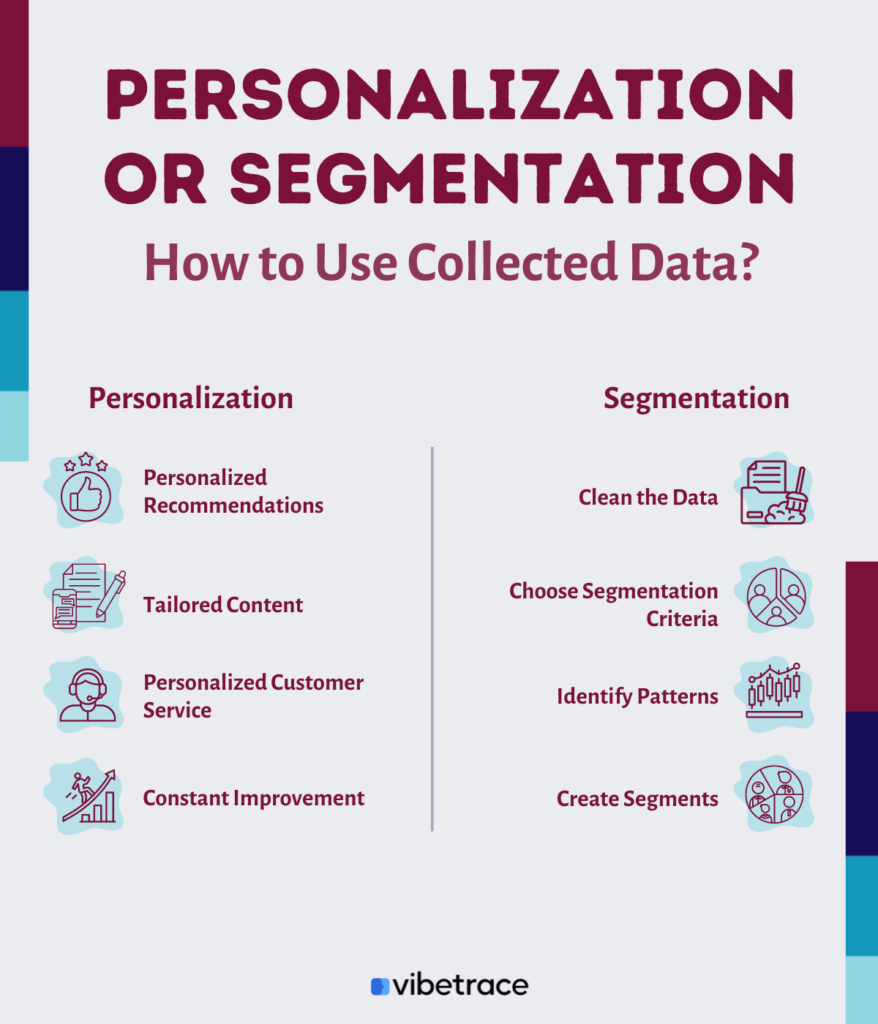Today’s competition and business environment call for a customer-centric approach.
That’s the only way to guarantee that all the research, efforts, and tweaking of ads and campaigns won’t go to waste. And – that you’ll achieve your business goals and the desired profits.
A business must perfectly understand its customers if it is after success.
That’s where segmentation and personalization come into play. If you want to apply that approach in your business, to understand what customers require of your business, to identify their pain points and the solutions they seek, you need data. And lots of it.
If you haven’t developed your strategy for collecting customer data to segment audiences and personalize communication, you’re in the right spot.
Let’s start with the basics!
Segmentation vs. Personalization
Segmentation and personalization are crucial aspects of any business that strives for success. To learn more about both processes, read our detailed guide on segmentation vs. personalization to understand their role in marketing. That will help you better understand how they work together to help you achieve optimal results.
In today’s article, to help you more easily incorporate these strategies, we’ll start by recapping their key differences:
- Segmentation encompasses breaking down your target audience into different groups (segments) that have similar characteristics. Because of these similar traits, you can send similar communication to the people present in specific segments.
- Personalization encompasses tailoring communication, recommendations, and offers to a customer’s specific behavior and interactions with the brand. That tailoring allows you to create more relevant messages and enhances the customer experience.
Data availability marks the starting point for either. If you don’t have enough data, you can’t make relevant segments, let alone craft meaningful communication. But what does “enough” mean, and is there such a thing as information overload when collecting data?
Keep reading, and you’ll find the answers to these exact questions. Let’s start with collecting the coveted data.
Below, we’ll explore the best and most viable tactics for collecting the needed information. Let’s get started!
7 Ways to Collect Invaluable Data
The people-centric marketing era relies on empowering customers through relevant and helpful information. To achieve that, you must better understand the people in your target audience. Here are the top 7 ways in which you can approach collecting data for segmentation and personalization:

1. Use Surveys & Quizzes
Surveys and quizzes can be one of your primary sources of zero-party data. That’s information customers share willingly and directly with your business. When you craft surveys and quizzes carefully, you can gain valuable insights into customer preferences and needs.
Let’s consider an example. A customer visits a cosmetics store and gets a skin type quiz. The retailer develops such a quiz specifically to glean the customer’s needs. Feed the information into a product recommendations engine that will help generate relevant cosmetics offers. It will make recommendations based on the needs and preferences that the customer shared.
Surveys and quizzes allow you to eliminate the guesswork, often present in crafting buyer personas and defining the ideal customer.
Surveys and quizzes always have a specific goal – you make them to extract targeted information. You can use them to understand how the customers use your products, identify their interests, and acquire feedback. That’s the reason such tactics can play a vital role in your efforts to personalize experiences.
2. Use Web & App Analytics
Web and app analytics provide a powerful way to gain insights into how people interact with your app or website. You can learn how they navigate and use your marketing communication and platforms.
That’s a source of statistical information like CTRs, conversions, drop-off rates, etc. Web and app analytics can inform you how long people spend on your site and how many pages they visit every time. What metrics you’ll track depends on your needs. You must predetermine relevant OKRs and KPIs to monitor when measuring success.
All this provides insights into the user behavior, customer needs, and pain points. When you identify data patterns, you can create meaningful segments and personalize communication based on individual needs and preferences.
3. Leverage Social Listening
Social listening is a powerful approach to collecting relevant data. With social media being an integral part of our modern lives, you can acquire tons of information by listening in.
You can browse reviews for similar products on competitor websites and even Amazon. Additionally, you might want to participate in groups and forums and use various social listening tools to understand how people address your products.
That way, you can better understand people’s experiences with them and what they like or dislike about them. And most importantly – figure out if your brand and products can meet customer needs.
Social listening can get you closer to your audience and help you understand how people perceive your brand. Once you know that, you can better align your messages with customers’ needs and preferences.
4. Request Feedback & Reviews
Feedback and reviews are a great way to gather first-hand information on customers’ preferences and needs. You must proactively seek feedback. Sometimes you can even offer coupons and discounts to encourage people to share their feedback.
Customer feedback and reviews will help you understand what people like or dislike about your brand and products. That’s information you can leverage to create more meaningful segments and tailor messages and offers once you start personalizing communication.
Not to mention that reviews make for awesome UGC. User-generated content has proven invaluable for boosting conversions and increasing customer retention rates.
That way, you do use one stone to kill the two metaphorical birds – enhance customer experience and increase results.
5. Host a Focus Group
Focus groups are a pricey yet highly effective strategy. If you can spare the resources needed to host a focus group or a panel, you can gather in-depth insights from the source.
You can build the focus group around your current segments and assumptions about your customers. That will create a diverse pool of customers willing to share their thoughts and opinions in a more welcoming setting than faceless emails.
Those in-depth insights into customer preferences, needs, and expectations are your pool of qualitative data. Combine it with the quantitative information derived from tracked metrics, and you can further tailor your communication and personalize the experience.
6. Third-Party Software for Collecting Zero- & First-Party Data.
Once you integrate third-party software with your web properties, you can track user behavior and better understand customer motivations. Such tools provide a comprehensive overview of your visitors and existing customers. To learn more about these types of information, don’t miss out on our detailed guide on essential data types.
You can gather zero- and first-party data through forms, web and app analytics, and integrated instruments like a customer data platform for further analysis and segmentation.
These represent the two most valuable kinds of data that come straight from the source, aren’t tainted, and are highly informative and relevant.
The only downside is that such data is harder and more expensive to gather. And that leads me to the last viable strategy we’ll discuss in today’s article.
7. Third-Party Data
You can enrich the data you gather and expand your information pool with the help of third-party services and sources. Relevant information from third-party sources can greatly enhance your segmentation and personalization efforts.
On the other hand, don’t forget that third-party data is not very specific and contextualized by your business. In other words, worst-case scenario, such data might be irrelevant. That’s why, if you go after third-party data, you must spend the necessary time to clean it up.
Otherwise, you won’t be able to acquire meaningful insights that can help enhance your efforts and boost ROI.
We’ll discuss similar pitfalls later in this guide. In the meantime, let’s take a better look at the benefits that come from you spending the time and effort to collect data!
Benefits of Collecting Data for Personalization & Segmentation
Without a shadow of a doubt, collecting your own data from sources you own (like your app, website, or through direct email communication) is the best way to approach that task. That’s because the acquired information can help you in several ways:
- To enhance customer experiences with tailored offers thanks to highly relevant information;
- To boost customer satisfaction and build customer loyalty thanks to being hyper-relevant because of the acquired insights;
- To better understand customer needs and preferences to create more meaningful and relevant segments, as well as tailored content in the form of offers and recommendations;
- To drive positive change, improve communication, and enhance customer relationships based on relevant feedback and insightful information that comes straight from the source;
- To improve overall customer lifetime value and customer retention rate thanks to hyper-relevant communication and recommendations.
- To identify patterns in user behavior and preferences and increase revenues through better and timely upselling and cross-selling opportunities.
These are all a direct result of collecting data for personalization and segmentation. To reap these benefits, see how to put the collected data to work in the following two sections!

How to Use Collected Data for Personalization?
Personalization is one of the most robust instruments a business can use. It enhances the customer experience and boosts ROI. And it’s highly dependent on the data you gather. Here are four key ways in which you can use the available information and insights to boost personalization:
1. Personalized Recommendations
Apart from analyzing the available data, you can feed it to a customer data platform and leverage it to power a product recommendations engine. Pay attention to information like:
- purchase history;
- buying behavior;
- preferences;
- site and communication interactions.
Once you combine it with the powerful algorithms and AI capabilities of the engine, it can generate relevant offers and product recommendations.
Use that approach to leverage upsell and cross-selling opportunities and nurture repeat-buying behavior in your customers.
2. Tailored Content
Customers interact with your business at various touchpoints when moving along their customer journey. You can enhance those interactions through tailored content based on the gathered data.
Analyzing it will help you:
- discover relevant topics to develop on your blog;
- create meaningful posts for your social media accounts;
- improve email campaigns through recommendations;
- enhance website experiences with dynamic content and overall web personalization, etc.
Tailoring content makes brand messages more relevant and relatable, which, in turn, helps build stronger, long-lasting customer relationships.
3. Personalized Customer Service
Customers like to know that brands care about their needs and preferences. You can demonstrate that in various ways. Let’s take, for example, the rare but essential post-purchase care.
Reach out to your customers and find out if everything went smoothly with their purchase. Inquire whether they’re satisfied with the product, and use the opportunity to acquire feedback and even user-generated content.
That’s a single example of what personalized customer service looks like. You can imagine the positive impact it can have on customer relationships and loyalty.
4. Constant Improvement
Customer behavior provides valuable insights that you can leverage to enhance your business performance. Feedback, reviews, information gathered through surveys, and so on can help you identify elements and aspects of your business that you can improve.
This continuous improvement will further strengthen customer relationships and reinforce loyalty. That’s because people see the brand’s willingness to improve for their sake.
That’s why, personalization is crucial to long-term success, especially given how competitive the business environment is.
But before you can start personalizing communication, messages, and offers, you must first use the collected data to segment your customer base. Let’s see how!
How to Use Collected Data for Customer Segmentation?
Segmentation is central for identifying customer groups worth your time, efforts, and investments. If you don’t segment data, you’re wasting its potential, and there’s no point in collecting data to begin with.
But if you don’t segment data, you can’t personalize messages and can’t achieve a coherent presence across communication channels. Let’s look at four key ways to use the collected data for segmentation:
1. Clean the Data
Often, you might find duplicate entries, might come across invalid email addresses and phone numbers, might have irrelevant data submitted by people who don’t care about your business, only how it works.
That’s why it’s so important to clean the database you have.
Standardize the format of the entries, even edit them to fix issues or something as simple as the capitalization of names. Only this can guarantee you’ll have relevant information ready to segment.
2. Choose Segmentation Criteria
Businesses are fundamentally different. Choosing segmentation criteria is strictly individual and depends on the business needs and goals.
For example, you might operate locally – in a city or a state. In that case, geographic information and segmentation are irrelevant – you already know where your customers are.
Consider your goals and needs, and align them with the available data to create the most meaningful segments. Explore the various groups you can make based on different criteria in our detailed segmentation vs. personalization guide.
3. Identify Patterns
Carry out an in-depth analysis of the available data. That will help you identify patterns in customer behavior, preferences, and even mundane aspects such as demographics.
You can then use those patterns to unite seemingly different people in a promising segment.
The analysis will guide you in creating distinct groups with enough people. Remember that if you go too specific, you will miss out on opportunities. Making your segments too narrow will hurt your business.
4. Create Segments
The last step when handling available data is breaking down the customer base into specific groups with similar characteristics – the segments in question. There are several aspects to pay attention to:
- Ensure the people within a segment have similar characteristics to ensure the homogeneity of the segments. Otherwise, targeted communication might fall flat.
- Ensure the segments are different enough to justify their existence. Otherwise, you’ll be spreading your efforts thin. For segments that are too similar, you can use the same approach to save time and effort.
- Ensure segments are large enough. For example, if you work in retail but have a segment of just 20 people, you’re narrowing down too heavily. Such granularity will limit generated results and shut down opportunities.
Once you start targeting customer segments with tailored content and personalized messages, it’s time to start monitoring results. You must be agile and flexible enough to adjust to sudden changes in customer behavior.
The e-commerce field is dynamic, and you need to adapt. Customers change their preferences, their needs evolve, and even their shopping habits can be dramatically altered – take the time of the pandemic, for example.
Monitor and evaluate how meaningful and promising the segments are, and adjust them if the results don’t satisfy you. Additionally, if new information suggests changes are afoot, be ready to act on that new data and adjust as well.
But there’s one rule of thumb to adopt – don’t push blindly toward more data. There are countless pitfalls related to the pursuit of information. Below, we’ll discuss the most significant of them.
Do you like this article?
Join Mary and the Marketing Automation dedicated newsletter!

Stay connected to what’s really important to optimize your digital revenues.
By clicking the button, you accept our Terms & Conditions. Also you will need to confirm your email address.
Pitfalls & Most Common Errors When Collecting and Enriching Customer Data
It is of the utmost importance to avoid the most common pitfalls when collecting and enriching data. If you fail to do so, you risk creating irrelevant segments and crafting poorly customized messages. That’s why we worked on identifying and summarizing the five most common pitfalls for you to avoid:
1. Not Asking the Right Questions
We still make the mistake of making marketing about our business and not about our clients. Once you change that state of mind, you’ll start asking the right questions.
Customers have the right to opt out of sharing their data, and you must consider that. Give them that ability and proactively approach them to ask about their opinions and preferences and inquire about their needs. Ask questions that will gain informative answers and empower customers to express their needs and opinions.
2. Insufficient Data Sources
When you limit or underestimate the importance of some data sources, you’ll gather incomplete information. Two are the aspects of that:
- Favoring second- and third-party data because it’s easier and usually cheaper to acquire;
- Ignoring information from your CRM, underestimating the role sales plays, and underutilizing surveys to cut costs.
As a result, the gathered customer data will come with significant gaps. You need to diversify your data sources if you are after a better understanding and representation of your customers.
Besides, third-party data will soon stop being viable for e-commerce – better start preparing for that while you still have time to react.
3. Poor Data Quality
That’s where cleaning up the information and not relying solely on third-party data plays a major role. Data can be faulty and inaccurate, and it might become outdated (ask people to confirm their credentials and contact information regularly).
Auditing your database is essential to meaningful segmentation and effective personalization. What’s worse than not utilizing data is working with faulty and skewed insights and conclusions.
That will have a massive negative impact on customer experiences. Why?
Not utilizing data would cause you to create standardized messages that might fall flat sometimes. Faulty conclusions due to poor-quality data can lead to irrelevant messages that drive people away.
Finally, keep in mind that when you buy third-party data, you compete for the attention of those people with every other buyer. And don’t forget that when you buy third-party data, you might start targeting people who are in no way interested in what you offer.
4. Focusing on Quantity Over Quality
Qualitative data always offers better actionable insights. Information can indeed make or break a business, but it’s not just the quantity that impacts operations. It’s the quality that mitigates the risks.
In your effort to acquire as much data as possible, you might overlook some important characteristics we discussed previously. Of them, being relevant is crucial. The data you gather must be important to your business goals and needs if you want to derive actionable insights and valuable conclusions.
Remember – you can’t break down irrelevant data into relevant segments! It will only overwhelm and muddle your efforts. You must embrace the acquisition of relevant, high-quality data, not just any type of information, as a priority.
5. Overlooking Data Privacy Regulations
Data privacy has grown in importance over the years. Today, it’s the one thing customers want to be guaranteed when sharing sensitive data like their email, delivery address, birthday, and payment details.
When you offer goods and services, you end up handling data. As a result, you must ensure that your business complies with relevant data protection laws – the California Consumer Privacy Act (CCPA) and even the infamous GDPR if you work with European customers.
Data security and protection must come second only to collecting quality data in legal and ethical ways. Otherwise, you’re opening your business to legal action and making it vulnerable. Besides, maintaining high privacy standards further strengthens customer relationships and helps with building trust.
Ready to Start Collecting Data for Personalization & Segmentation?
Collecting and enriching customer data is a delicate matter and a leading aspect of any business that aims to gain valuable and actionable insights. Data has proven its essential role in developing meaningful segments.
As a result, you can craft personalized messages and tailored content that resonates with customers and can convert them.
While chasing massive amounts of data, don’t forget that it’s better to collect relevant than lots of information. In your pursuit to gain tons of data, you might overlook its more valuable qualities.
Pace yourself, prioritize quality over quantity, and clean up data from duplicates, irrelevant entries, and outdated data points. Understand the importance of data governance and embrace data privacy as a priority. Only then will you be able to harness the full potential of available data.
You can start today by integrating robust tools into your everyday work. They will help you stay compliant and maintain your integrity while making the most out of your data.
The VibeTrace all-in-one marketing platform includes a sophisticated customer data platform. It will keep data at your fingertips and help you organize it into meaningful segments. You can use its refined product recommendations engine to tailor content for these segments and take your personalization efforts to the next level.
Book your free demo today and see the platform in action!

